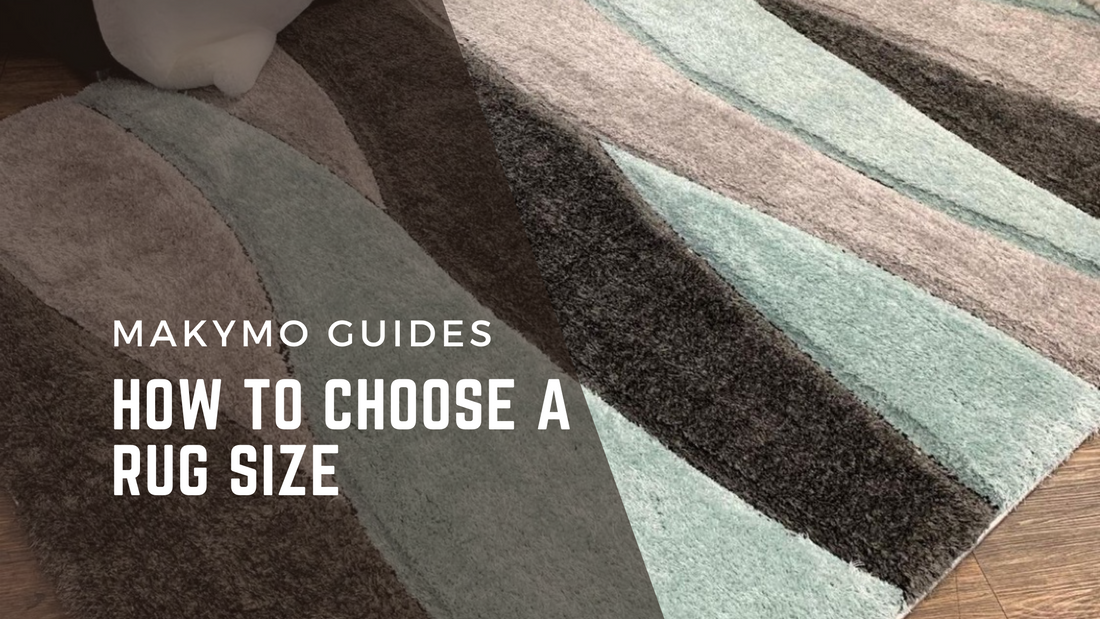
How to Choose a Rug Size: What Works Where?
Share
How to Choose a Rug Size: What Works Where?
Rug placement can make or break a room because the size of a rug can either compliment or contradict the look you are going for. A well-chosen and well-placed rug has the power to pull an entire room together by accenting your carefully selected furniture, statement art pieces and other home and office décor and accessories.
A rug can also easily overpower a space if it is not selected wisely and placed effectively. For instance, the perfect rug for a master bedroom is unlikely to work well under the dining room table for a variety of reasons. You see, while appearance and style are important, they are not the only elements to consider when choosing a floor rug.
One of the most important factors to consider is what size will work best in the space you are furnishing. Different materials also have an impact on the look and feel of the room and finding the right sized rug is essential for a sophisticated, cohesive look.
Here are few golden rules to follow regarding rug sizing that can make all the difference in your search.
4 Tips to Find the Ideal Rug Size and Shape
You may want to consider these four things before choosing the style, color, or material of your rug. Room shape, furniture shape, size and placement dictate the rug size and orientation. We recommend you determine the design style you are going for and then let the space dictate the rug shape and size and then find a rug to match.
To determine the right rug size for a particular room, start by asking yourself the following questions:
- How much floor space do you have available?
- How will the furniture in the room coordinate or contrast or offset the rug?
- What is the primary purpose of the rug? Will it be used as a decorative floor piece or as a functional floor covering in high traffic areas?
- Are you trying to tie the décor in a space together or to define a separate area in the room?

Rug Sizing Rules of Thumb
-
Plan to have at least 18 inches between the edge of a rug and the wall
-
Large rugs can help make small rooms appear larger
-
Round rugs work best in corners or in areas that you want to draw attention to
-
When it comes to dining room tables and chairs, they should be supported by a rug, even when pulled out from the table
-
In bedrooms, the rug should match the orientation of the bed and side tables
-
Whatever type of rug choose, the rug pad beneath it should always be slightly smaller than the rug
What is a Rug Pad and Why Do You Need One?
A rug pad is made to cling to the floor and the underneath layer of a carpet or rug to ensure it does not move from where it was originally placed and aesthetically meant to be in the room. It is also used as a safety precaution to help the rug from sliding around when it is walked on as loose rugs of are a tripping and falling hazard.
Rug pads are a must when placing rugs. Not only do they help keep everything in place, but they help to give the room a more finished look by solidifying the placement of the rug. Loose rugs are a hazard in the home, and a skewed rug is as much of an interior design faux pas as a tilted picture frame.
Whatever size you plan to buy, make sure the rug is roughly one inch longer than the pad on every edge then secure the rug pad to the underside of the rug with painter's tape, and you are all set!
Rug Sizes by Room
From a long, narrow rectangular welcome rug at the front door to a fluffy square throw under the sofa to a round floor piece under the dining room table, there are many different things to consider when sizing a rug for a room. The furniture you have determines a lot about what rug you should choose, as does the room you are styling.
Entry Way
The shape of the entry way or foyer will naturally dictate which rug will look best in the space whether that is round, square or rectangular. Another determining factor is the width of the front door. At a minimum, the width of the rug should mirror that of the entryway door. Prior to purchasing, you will also want to check the pile height to make sure that the base of the door will clear the rug.
Hallway
Runners are made for corridors, so they are an easy go-to when choosing floor pieces for these long, narrow spaces. If you choose to place furniture in these areas, it’s best to keep rugs free of all tables and chairs.
Dining Room Rug Sizes

If you have a separate dining room, the table is a natural focal point. You’ll want to make sure all furniture legs fit comfortably on the rug and that there is no less than 18 inches between the outer edge of the rug and the wall.
The shape of the rug should mirror the shape of the table. For example, you will want to place a round rug beneath a round table and the ideal rug for a square table is a square rug. In the case of a traditional rectangular table with six to eight chairs, a 9 x 12-foot area rug is the best choice. To place a rug in any room, like a professional, simply remember to match the rug to the table shape.
Defining the Dining Area
Many modern homes have an open-plan kitchen, living, and dining room area. In these rooms that are designed with an open layout, rugs are the perfect way to define one particular space or designated zone. For instance, you may want to creating a sitting area or a game room or distinguish between a formal space and a more casual gathering space. An open floor plan creates a great opportunity to use your imagination to play with various shapes in order to define your living space.Two popular options for creatively accenting the seating area for dining is to use vintage or cowhides rugs.
Living Room Rug Sizes

Stuck on how to design your living room furniture layout? Given that that there are so many options, finding a rug to complement and enhance the room and knowing where to start can feel overwhelming. Let us help!
Looking for a rug that will create an illusion of a larger space, opt for a large rug that will accommodate all of your furniture's to sit on it fully with all legs on the rug. Just be sure that there is enough space (at least 18 inches from the wall on all sides) around the edges of the rug.
If you have one primary sofa, another tip is to align the rug with it, sitting only the front legs on top. There should be a few inches extra on either side. Secondary sofas as well as accent chairs should also have the front legs on the rug – especially in a smaller space.
Tips for Coffee Table Rugs
Small rugs placed in the center of living room furniture beneath a coffee table can add an element of warmth to a room and can be used to create a modern look.
Small area rugs in vibrant styles, such as Moroccan rugs or bohemian styles can be a great compliment to a coffee table. Faux fur rugs and cowhide rugs are also great options for furnishing and drawing attention to smaller spaces.
Lastly, be sure you don’t crowd the area with other furniture, plants, baskets or other décor. This look is complete with the coffee table as a stand-alone furniture piece on the rug.
Bedroom Rug Sizing Pointers

When assessing the layout of a bedroom to determine rug placement, use the bed (and side table(s) as the focal point of the room. Here we will share some tips for adding a rug to a room with a king, queen, double and twin-size bed.
When considering the shape of the room and orientation of the rug, be sure to keep the entry way and main walkways in the room clear. When placing the rug, plan for the rug to extend 18 to 24” past the end of the bed for the most aesthetic appeal.
In a larger room with a king or queen-size bed, the entire bed and side tables can sit atop a vertical 9 x 12’ rug (or a larger sized rug if the room allows). This does not account for dressers and floor lamps which would be placed on the peripheral space around the room.
As an alternative, you may want to place the rug horizontally at the foot of the bed extending approximately one third of the way to the top of the bed. When placed in this area, rugs help to draw attention to the bed without separating it entirely. Or for a symmetrical look, use an 8’ x 10’ rug for a queen bed and a 9’ x 12’ for a king.
An 8’ x10’ rug is ideal for a double or twin bedroom set including the bedframe and end tables. Another popular bedroom style is to place a small rug at the side of the double or twin bed. A bedroom rug should feel cozy, inviting, and should be soft underfoot. A fluffy bedside rug feels great on tired feet at the end of the day and stepping onto a soft high pile height rug or faux fur material is a soft landing for your feet as your start your day each morning.
Runners are another creative way to stylize a bedroom. Placing runners on both sides of the bed can be a great option for beds of all spaces. The width of the runner should be slightly larger than the night stands and the length should be slightly less than the length of the bed.
Kitchen
A runner can visually lengthen the room and works well in a kitchen with a large island with bar stools or chairs or a gallery kitchen with long walkways. A U-shaped kitchen can benefit from a small rectangular rug placed in front of the sink area to accent this type of kitchen layout.
If you want more advice on what rug size, style, shape and texture will work best in your home or commercial space, visit Makymo’s online store to see their inspiring collections and designs!
